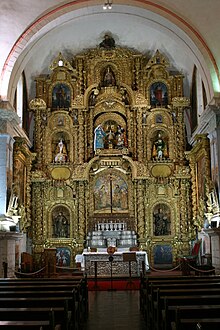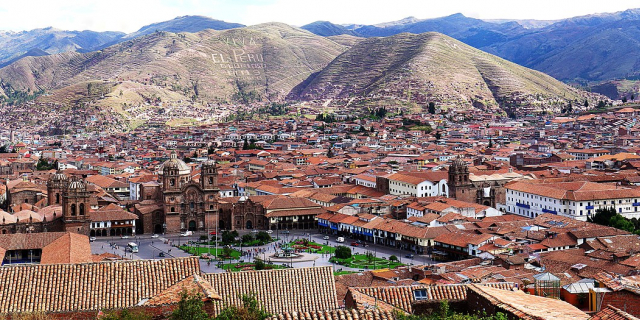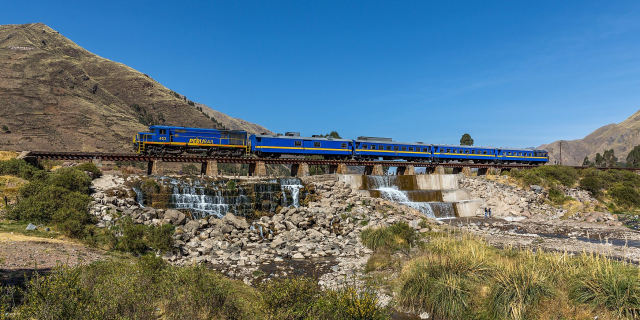Catedral del Cuzco
( Cusco Cathedral )The Cathedral of Cusco or Cathedral Basilica of the Virgin of the Assumption is the main temple of the city of Cusco, in Peru and houses the headquarters of the Archdiocese of Cusco. The Cathedral Basilica of Cusco, together with the Triunfo temple make up the Cathedral Complex, it is located in the northeast sector of the current Plaza de Armas of Cusco. In the place that, during the Inca period, was occupied by both the Suntor Wassi (lit. "Government House") and the Kisoarkancha or Palace of the eighth Inca Viracocha. The complex occupies an area of 3,920 square meters and is the most important religious monument in the Historic Center of Cusco.
Since 1972 the temple has been part of the Monumental Zone of Cusco declared as a Historical Monument of Peru. Also, in 1983, being part of the historic center of the city of Cusco, it is part of the central zone declared by UNESCO as World Heritage Site.
The Incas built the temple known as Kiswarkancha[1] on the main square in Cusco. It was the Inca palace of Viracocha, ruler of the Kingdom of Cusco around a century before the Spanish colonists arrived. The aboriginal name of this city was Qusqu. Although it was used in Quechua, its origin has been found in the Aymara language. The word itself originated in the phrase qusqu wanka ("Rock of the owl"), attending to the foundational myth of the Ayar siblings.[2]
Near to the Kiswarkancha was the Suntur Wasi, an armoury and heraldry centre for the Inca royalty.[1] When the Spanish conquistadores arrived in Cuzco, they decided to take down the temple and build their Christian cathedral in that prominent site.
Basilica Cathedral of our Lady of Assumption Colonial paintings in the interior
Colonial paintings in the interior Interior of the cathedral and the late-Gothic image of the virgin
Interior of the cathedral and the late-Gothic image of the virgin Altarpiece
Altarpiece Church of la Compañía de Jesús
Church of la Compañía de Jesús... Well, this reaches me highly, existing, among the regions recently discovered under the auspices of the ever augustus emperor of the Romans, our very beloved son Charles, who is at the same time king of Castile, León and Aragon, existing a region called Peru whose inhabitants are knowledgeable about the divine law, and in which region many Christian Indians live; and wishing the same Emperor and King Charles with religious affection, that in the aforementioned region of Peru, subject to his mandate, the cult of that most glorious name (Christ) of whom is the entire universe, and all its plenitude and everything in it exists; may its inhabitants be led to the light of truth and spread the salvation of souls; and also wishing that the city of Cusco located in the same region where there is already a Church under the title of Santa María, be elevated to the rank of City and Diocese and the former Church of Santa María to Cathedral Church. Given in Rome next to St. Peter year etc. February 13, one thousand five hundred thirty-six.
The Cathedral of Cusco is the result of various projects carried out by different architects who took over at the head of the works. The first cathedral in Cusco is the Iglesia del Triunfo, built in 1539 on the basis of the palace of Viracocha Inca. At present, this church is an auxiliary chapel of the Cathedral.
The cathedral of Cusco, like that of Lima, is a temple with three naves with two more chapels and a flat front wall. (...) The three naves are of equal height, as in the cathedrals of Lima and Jaén. This last one was the immediate precedent of the two Peruvian cathedrals.
In 1538, after the return of Vicente Valverde with the cédulas reales that recognized him as bishop of Cusco, he began the construction of a cathedral by order of erection on September 4, 1538. However, this work would remain in its infancy, as can be deduced from the response of the Cabildo of Cusco to the request of the Cathedral dean Luis de Morales, which indicated that the work would be suspended until the following summer. In the following years, given the narrowness of the assigned site, an attempt was made to move the cathedral first to the part that formerly corresponded to the Palace of Pachacuti called Qasana and that Francisco Pizarro reserved for him (current Portal de Panes of the Plaza de Armas). However, that move was impossible because, in 1538, Pizarro had given that lot to the Franciscans. It was then sought to use the part of the old Cusipata where the Hotel de Turistas del Cusco currently stands, but this idea was also discarded around the 1540s due to the opposition of the Mercedarians who had already occupied the site that they still occupy today and who it would be very close to the cathedral.
Faced with this situation, at the initiative of the second bishop of Cusco Juan Solano, the Cabildo decided to purchase the Alonso de Mesa lot adjacent to the one assigned for the construction of the cathedral and which corresponded to the old Kiswarcancha that was the Viracocha palace. This decision was made on May 17, 1552.
Between the years 1560 and 1664 the Cathedral Basilica of this city was built. Its construction was entrusted to Juan Miguel de Veramendi in 1560, who was replaced one year later by Juan Correa who worked until 1564. This was followed by Juan Rodríguez de Rivera, Juan Cárdenas, Juan Toledano and Bartolomé Carrión. However, when Viceroy Francisco de Toledo arrived in Cusco between 1570 and 1572, the construction of the cathedral was stopped. In 1615, Miguel Gutiérrez Sencio, an architect who followed Vitruvius and Giacomo Barozzi, and an admirer of the sober and pure style (Herrerian style) established by Juan de Herrera in El Escorial Monastery, took over the direction of the work, along with Francisco Becerra. Under their direction, the Cathedral of Cuzco was completed in 1654.[4][3]
The 1650 earthquake caused little damage to the cathedral except for the collapse of the ribbed vault.[5] This earthquake motivated the change of the planes of the facade in its upper part and the suppression of the third body in the towers, which is why there is too much volume in the body, leaving the towers short, giving the appearance of solidity to the building.
The premiere mass of the cathedral was on August 15, 1654 and its definitive consecration was on August 19, 1668 by the thirteenth bishop of Cusco Bernardo de Isaguirre Reyes.[3]
The construction material was stone from nearby areas and red granite blocks were also reused from the fortress known as Sacsayhuamán.
It was recognized as a Basilica of the Catholic Church on February 8, 1928. The construction, with three naves, stands on a hall-type floor plan. A surprising detail is the fusion between the order of the capitals and friezes and the type of roof used: the ribbed vault, characteristic of the Gothic. This gives rise to a surprising amalgamation of styles, frequent in the Baroque style of Latin America. The famous image of the Lord of the Earthquakes is venerated in the cathedral.
This cathedral, with a Renaissance façade and Baroque, late-Gothic and Plateresque interiors,[3] has one of the most outstanding examples of colonial gold work. Equally important are its carved wooden altars.
Since in this city the painting on canvas of the famous Cusco School of painting was developed, the most important in Colonial America, important samples of local artists who follow this school can be seen precisely in the cathedral.



































Add new comment